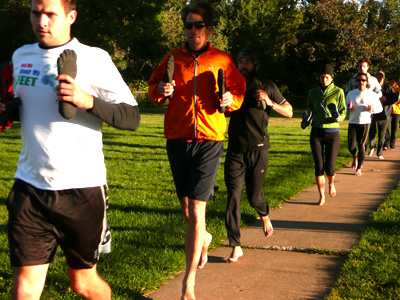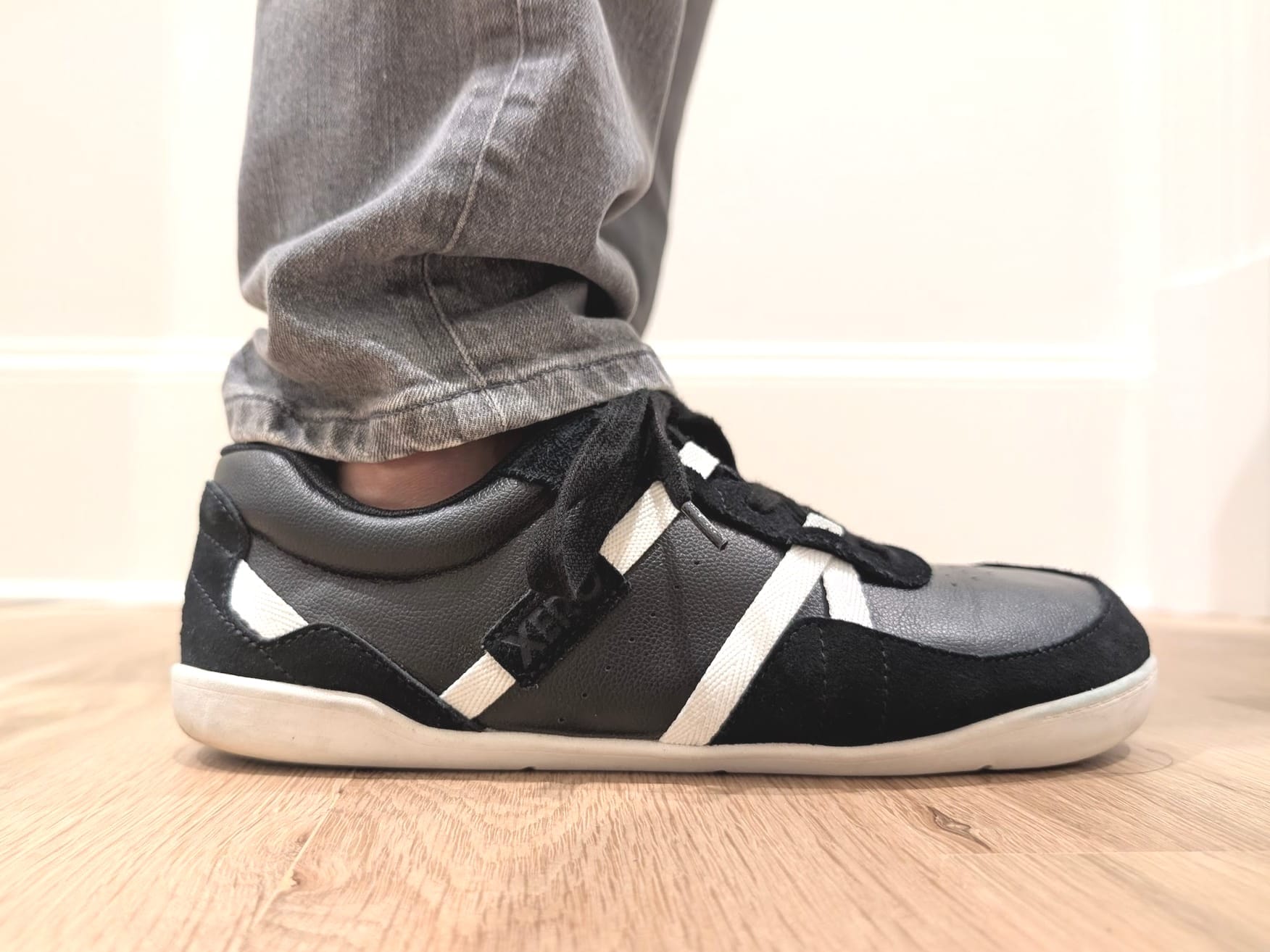How to Transition to Running in Vibram Five Fingers — Let Your Skin be the Guide!
Pro-tip — Before you take off in your brand new Vibram Five Fingers, seriously consider going barefoot first. Build stronger feet and diminish your risk of injury. Chances are you’ve just purchased your first pair of Five Fingers, or are conside…


NOTE: Before you take off in your brand new Vibram Five Fingers, seriously consider going barefoot first. Build stronger feet and diminish your risk of injury.
Guest post by Michael Sandler and Jessica Lee of RunBare.com
Chances are you’ve just purchased your first pair of Vibram Five Fingers, or are considering getting a pair. They’re a lot of fun, and you’ll likely soon find yourself with a near permanent case of the ear-to-ear grin.
But this is a double-edged sword, because if anything, Vibrams are too much fun.
If you don’t learn to go slow in the beginning, sooner or later the perma-grin you’re experiencing may be replaced with a perma-ouch.
Running in Five Fingers feels so much like being a kid all over again. They’re just so much fun we can’t help but overdo ourselves. We go too far, and too fast, before our feet our ready, and then BLAMMO, we hit the dreaded ‘setback’.
But this doesn’t have to be the case. If you go slow, and let your skin be your guide (more on this in a minute) you’ll build the strongest, healthiest, happiest feet in the world, capable of mile after mile of near effortless enjoyment, fast and free in or out of your Five Fingers.
But first, we need to wake things up slowly. Unfortunately, modern shoes have weakened our feet. ...
In short, our feet have been asleep for years, trapped in a dark, narrow constrictive boot that has shortened, weakened, and stiffened our muscles, tendons, and ligaments, and left our bones weak and brittle. We can build them incredibly strong and supple, but it takes time. If you do too much before they’re ready, you risk tendonitis, muscle tears, strained ligaments, or stress fractures.
To avoid all of this, you need to go slow, and consider tiny distances to begin with.
Let your skin be your guide
Over time, your Five Fingers can help you become the strong, efficient, healthy and fast runner you were born to be. But to transition safely, you need to first feel the ground by going fully barefoot. If you take the time to feel the ground, build your feet, and develop your stride, you greatly diminish your chances of injury when it comes time to slipping on your Five Fingers.
When you run fully barefoot, you learn to run incredibly light, because you can fully ‘feel’ the ground and your impact. Most importantly, when your skin gets raw and tender, you stop and head for home. There aren’t too many people out there who will push through raw skin or a blister, at least not on an easy training run. That’s why I always tell my runners, “Let your skin be your guide.”
When you let your skin be your guide, you protect everything underneath the skin. The challenge with Vibram Five Fingers is not that your skin gets raw, it’s that it doesn’t. You also don’t feel the cumulative damage you’re doing to weakened parts on the inside of your foot. First off, your muscles are still asleep, and aren’t used to the new stride yet. Second, even if the muscles are ready, the tendons that attach the muscles to the bones are still asleep. Third, EVEN if the muscles and tendons are ready, your bones haven’t grown beefier to handle the muscles and tendons pulling at their attachment points. You also haven’t developed the flexibility for the foot to handle a full range of motion, stride after stride, mile after mile. And last, you haven’t developed the ‘padding’ in your foot, to help naturally cushion the impact.
Add all of this up, and you’ll find if you do too much too quickly, you’ll soon tear your feet apart.
If you buy Vibrams, have fun exploring in them. Just don’t go running too far in them just yet. Instead, invest in your future with a month or two of barefoot running first. Consider this foot conditioning — or boot camp for your feet — to wake them back up and help them get strong. So, before running far in your Vibrams, begin running fully barefoot, and let your skin be your guide.
But I feel great in my Vibram Five Fingers!
Even if you think all is good, it’s likely not the case. Our bodies follow the use-it or lose-it principle and the principle of ‘specificity.’ This means if we use something we get stronger, if not, it goes away. And it means if we’re used to a specific movement, we get stronger for it, and if not, we lose the ability (at least in the short run) to perform that specific movement. These two principles dramatically affect our feet and the transition into Vibram Five Fingers- and barefoot-running.
Ways in Which Our Feet have Gone Soft and become Weak
1. Our Arches are Asleep
With ‘great arch support’ found in traditional running shoes, our strong and springy arches haven’t had to work. Moreover, by relying on arch support, we’ve locked out one of nature’s greatest shock absorbers and stabilizers, and reduced our arches to mush. They can be rebuilt and raised up stronger than ever; however, you have to start slow. Wisely, Vibram Five Fingers are built with minimum arch support. That’s great for letting your foot do the work. But, if you do too much too fast, your muscles won’t be able to handle the new workload. Instead, you’ll force the job onto your plantar fascia, the band of easily-upset connective tissue running the length of the bottom of your foot. It was never meant to handle such force, and can quickly lead to plantar fasciitis.
2. We’ve Lost Flexibility
Our incredible foot flexibility and dexterity has been eliminated by stiff soles and over-effective ‘motion control’ systems. Our feet were meant to bend and flex, fore and aft, and to the sides. This allows us to absorb impact, use the foot as a spring, and handle uneven terrain and rocky surfaces. We once had incredibly flexible feet – just look at those of a baby. But now our feet have become as rigid as our shoes. While we never twist our feet in our shoes, that’s exactly what you’ll need to do in your Five Fingers for terrain, propulsion, and shock absorption. It’s a big part of what makes us feel ‘free.’ However, building this flexibility takes time. Do too much too fast, and you risk tendinitis, strained ligaments, tears, or even a stress fracture by putting new forces on your feet.
3. Our Achilles and Calves Have Weakened and Shortened
Ever taken a close look at the heel of your shoe? Chances are it’s almost an inch high or greater. Now, I’m not talking about high heeled shoes, but your running shoes. Supposedly, this high heel helps ‘protect’ our foot with extra cushioning. But what it really does is prevent your foot from its full range of motion. Our bodies adapt to raised heels by shortening our Achilles and calves. To add insult to injury, when we’re forced to heel strike, we lock our Achilles out of the equation. The Achilles can handle almost two tons of force if fully strengthened, but in a modern running shoe that promotes heel striking, it hasn’t had to work.
Vibrams, however, allow you to use a more ‘natural’ stride, and that means landing on your forefoot, loading your Achilles and calf, and springing back with each step. That’s why the Achilles was built so strong in the first place and it takes time to build them up again. Work your calves and Achilles too much and too soon and you’ll pull and strain these muscles and tendons, or literally tear them apart.
4. Our Incredible Toes Have Become Unbelievably Weak
Did you know 18 out of 19 muscles and tendons of our feet connect to our toes? Mother Nature wouldn’t have done this if the toes weren’t vital to our feet. Unfortunately, our poor toes have been asleep for years. Look at your current running shoes. See how high the front of the shoe is off the ground? That’s called ‘toe spring’. Shoe manufacturers add toe spring to help your foot roll more easily. Now look at your foot. Are your toes up and off the ground? Far from it! We grab with our toes, support ourselves with our toes, and keep our arches strong with our toes. Strong toes and the attaching muscles are essential for our stride and healthy feet. When you have strong toes, you have a strong foot. But in a shoe with toe-spring, there’s no way for our toes to spread, grab, or feel the ground. This atrophies all connecting muscles, making them incredibly weak. Wake up your toes too quickly and you’ll start tearing your feet apart.
Getting Strong for Vibram Five Fingers
If you let your skin be your guide, you’ll find you rarely go too far. Instead, next time you get sore or tender, head for home.

Start barefoot, but remember to carry your shoes with you. Consider them your new handweights!
Try this on your next run: Start out barefoot but carry your Vibram Five Fingers with you. Then, when your skin starts to fatigue, put on the Five Fingers and head slowly for home. Don’t sprint home. Even if you only have a few hundred yards left to go, consider walking home.
As your feet toughen up, so will your muscles, connective tissue and more. You’ll also find your lightest stride possible.
There’s more to it than this, and great strength and conditioning exercises you can do for your feet and legs to make the transition go more quickly, but hopefully this is enough to get you going, and safely in the right direction. For more on getting into the sport, and beginner and advanced technique alike, check out our just-released Barefoot Running Book or keep an eye out for us as we endeavor on our 2010 Barefoot America tour.
Above all else, go slow and have fun. You’ll love your new ‘shoes’ be that the Five Fingers, or your incredibly strengthened new feet. And you’ll love your beaming new ear-to-ear grin, guaranteed to continue for years and years of running to come.
Have fun and we’ll catch you barefoot!
About the authors —

Michael Sandler and Jessica Lee Co-Founded the Barefoot Running Club in Boulder, Colorado, a club that grew quickly and was soon noticed by the Denver Post. RunBare.com was launched to serve as a "barefoot running school to help people looking to heal, to get back into running, to overcome adversity, reconnect with nature, and find a different way of living." Michael Sandler's background prior to barefoot running was as a speed skater and professional level cyclist — a past literally shattered after an inline skating accident involving a broken hip, arm, and shattered femur. Despite such adversity, Michael has gone from potentially never walking again to running ultramarathons and regularly running 80-100 miles a week. If you want to glean more of Michael's insights into barefoot running, check out his Barefoot Running Book. Also, keep an eye out for Jessica and Michael on their Barefoot America tour!
Thank you, Michael and Jessie!




